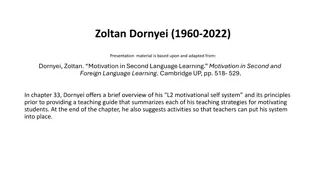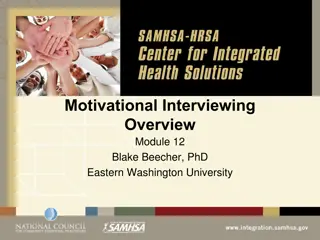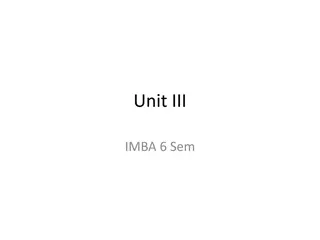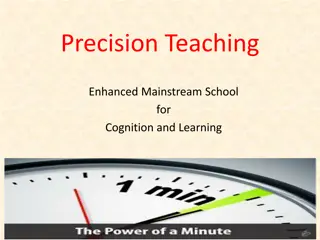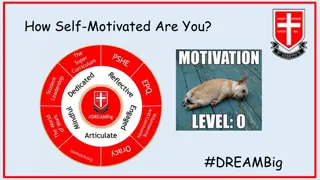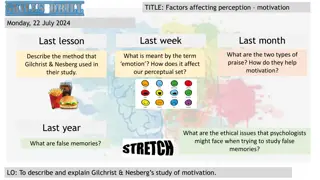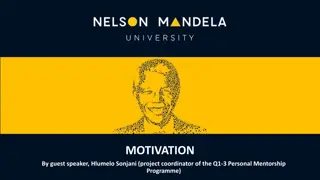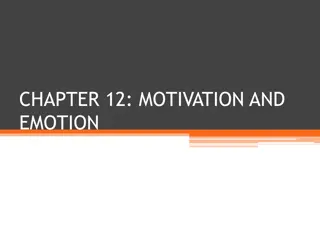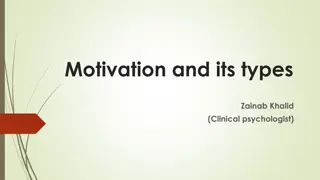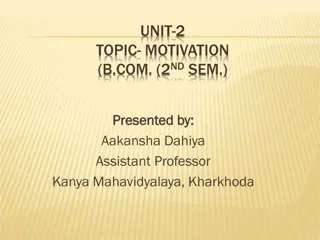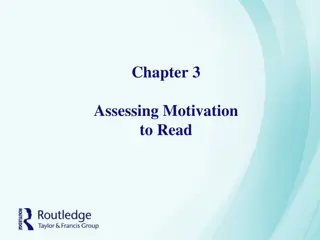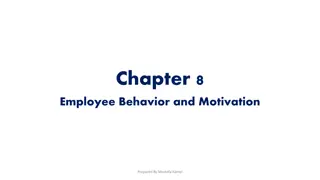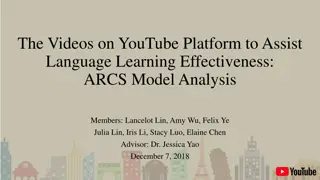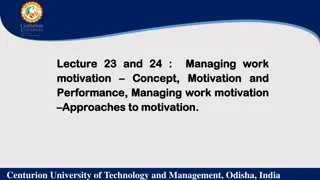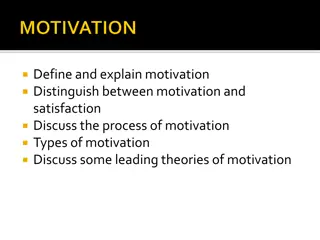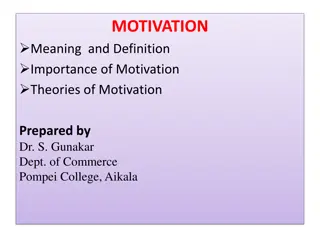Understanding Motivation in Teaching and Learning
Motivation is vital in education, with various sources like instructor-induced, learner-induced, and God-induced motivation. Teachers play a crucial role in stimulating and motivating learners to excel. Developing expertise, enthusiasm, and empathy are key components in fostering motivation. This summary delves into the importance of motivation in educational settings and strategies to enhance it.
Download Presentation

Please find below an Image/Link to download the presentation.
The content on the website is provided AS IS for your information and personal use only. It may not be sold, licensed, or shared on other websites without obtaining consent from the author. Download presentation by click this link. If you encounter any issues during the download, it is possible that the publisher has removed the file from their server.
E N D
Presentation Transcript
The Teacher and Motivation I'm not saying that I have this all together, that I have it made. But I am well on my way, reaching out for Christ, who has so wondrously reached out for me. Friends, don't get me wrong: By no means do I count myself an expert in all of this, but I've got my eye on the goal, where God is beckoning us onward to Jesus. I'm off and running, and I'm not turning back. (Philippians 3:12-14, MSG).
Course Objectives Develop and utilize motivational strategies in the learning environment that are suitable for his/her cultural context. Identify and contrast the differences in various types of motivation (intrinsic, extrinsic, and transcendent). Explain what is meant by motivation within the learning environment. Incorporate enthusiasm, encouragement, and empathy within one s teaching practice. Determine and explain seven components in instructor-induced motivation. Analyze how one can develop expertise in a subject area. Integrate real world learning and relevant assignments into lesson planning. List and explain five components of learner-induced motivation. Assess four components of God-induced motivation Determine four areas where a student needs to have a positive attitude in order to maximize motivation.
Motivation In and Out of the Classroom Motivation thrives on the desire or ambition to achieve a goal, combined with the energy and enthusiasm to work toward it. Needed to accomplish anything in life. Can be induced or inspired from within, without, and/or above. Three sources: Instructor-induced motivation Learner-induced motivation God-induced motivation
Instructor-induced Motivation Brought forth from without. The teacher is primarily a stimulator and motivator not the player, but the coach who excites and directs the players. The learner is primarily an investigator, discoverer, and a doer (Hendricks 1987, 37).
Instructor-induced Motivation Expertise Develop excellence in subject matter Students are motivated to learn from subject expert Some of the most memorable learning experiences the writer has had involved outstanding lecturers who generated a passion and contagious enthusiasm for the subject matter. These lectures had the personality, heart and soul of the lecturers, themselves (Galbraith 2004, 233). Enthusiasm Bring energy through intonation, eye contact, humor, surprise, challenge, suspense Avoid teaching outside of interest area Encourage Sincere praise provides effective reinforcement.
Instructor-induced Motivation Engage Provide choices and reasons for engaging in activities Use debate, questions, learner concerns People don t care how much you know, until they know how much you care. Empathy Feeling valued boosts output Feeling cared about attracts students Evaluate Making progress fuels motivation Timely feedback is crucial
Instructor-induced Motivation Enhance Effort Prepare, be relevant and organized Project what motivates instructor to study the course subject Use learner s preferred method style Not to the detriment or omission of best teaching styles for subject matter. Experience Incorporate real-world learning through instructor and student experiences Teaching should be valid, valuable and value added Some things are caught more than taught. Express/Explain Give rational for assignments Keep teaching simple and clear Work in a collaborative/cooperative manner
Learner-induced Motivation Called forth from within. The teacher may have prepared his finest. However, success or failure is largely up to the student. Generally speaking, motivation from within is longer lasting than external motivation.
Learner-induced Motivation Goal-Setting Does the course assist in achieving personal goals? Diagnosis Has the student determined a need for learning the subject? Values Is the subject aligned with the student s values? Energy Does the student possess the energy, intensity and vitality to learn? Potential Success or Failure Affix explanation for unexpected outcomes, probable causes and it s effect on success or failure. Desire Does the student have a desire to learn this subject? Willingness and Readiness Motivation is about effort and willingness. Learning is most effective when student is ready to learn. Course Significance Is the subject relevant?
Learner-induced Motivation Positive Attitude Does student have positive attitude toward subject matter, instructor, themselves, and the learning environment? A negative attitude towards any of these can deter motivation and hinder learning. (Issler and Habermas 1994, 105). Culture Individual motivation is inseparable from culture (Galbraith, 142). To motivate within a given culture, one must first understand cultural influences on behavior. - Requires cultural sensitivity - Strategies effective in one culture are not necessarily equally applicable to another. - Identify cultural motives and values that shape self-worth and well-being.
God-induced Motivation Sent forth from above. God has a purpose and plan for His people to reach their potential.
God-induced Motivation Pursuing His Commission: Matthew 28:19-20; Mark 16:15, 20; Luke 24:47-49; 2 Timothy 2:2 Pleasing God: Ecclesiastes 12:13; Galatians 1:10; 1 Thessalonians 2:4 Following His Plan: Proverbs 3:5-6; Psalms 37:23; Psalms 119:105; Jeremiah 29:11 Hearing His Voice: John 10:3-5 Obeying His Word: Psalms 119:99; 2 Timothy 2:15 Doing His Will: Romans 12:1-2; Ephesians 5:17; Colossians 1:9-10; John 4:34-35; John 9:4
Bibliography Cardelle-Elawar, Maria; Electronic Journal of Research in Educational Psychology. 2007. A Cross Cultural Analysis of Motivational Factors that Influence Teacher Identity. Glendale, AZ: Education & Psychology. http://www.investigacion-psicopedagogica.org/revista/articulos/13/english/Art_13_197.pdf. (accessed October 7, 2008). Cromley, Jennifer. 2000. Learning to Think, Learning to Learn: What the Science of Thinking and Learning Has to Offer Adult Education. : NIFL: National Institute for Literacy. NIFL. Earley, P. Christopher and Miriam Erez. 1997. The Transplanted Executive. New York: Oxford University Press. Galbraith, Michael W., ed. 2004. Adult Learning Methods: A Guide for Effective Instruction (Third Edition). Malabar, Florida: Krieger Publishing Company. ., ed. 2004. Adult Learning Methods: A Guide for Effective Instruction (Third Edition). Malabar, Florida: Krieger Publishing Company. Harris, Philip R. and Robert T. Moran. 1996. Managing Cultural Differences. Houston, Texas: Gulf Publishing Company. Hendricks, Howard. 1987. Teaching to Change Lives. Sisters, Oregon: Multnomah Publishers. Issler, Klaus and Ronald Habermas. 1994. How We Learn: A Christian Teacher's Guide to Educational Psychology. Eugene, Oregon: Resource Publications: An imprint of Wipf and Stock Publishers. Marshall, Marvin. Promoting Learning. Teachers.net. http://teachers.net/gazette/DEC01/marshall.html. (accessed July 25, 2008). Poitras, Melinda Danae. 2008. Here. Moments with Melinda, August 14, 2008, 2008. http://www.momentswithmelinda.blogspot.com/ (accessed October 7, 2008). Wikipedia, The Free Encyclopedia. The Little Engine that Could. http://en.wikipedia.org/wiki/The_Little_Engine_That_Could/ (accessed October 7, 2008). Yount, William R. 1996. Created to Learn: A Christian Teacher's Introduction to Educational Psychology. Nashville, Tennessee: Broadman & Holman Publishers.
Lesson In Review 1. 2. 3. 4. 5. 6. 7. 8. 9. 10. 11. 12. 13. 14. 15. 16. 17. 18. 19. 20. 21. 22. What is motivation? Within the theological school, how can motivation best be stimulated? Explain the difference between the three types of motivation mentioned in this lesson According to Howard Hendricks, what is the role of the teacher List two ways an instructor can develop expertise in his subject matter. How can a teacher project enthusiasm in the classroom? According to Galbraith, what are some of the most memorable learning experiences? How should praise be perceived by the learner? Why is it important for the instructor to be enthusiastic? Why is caring or showing empathy important in the learning environment? Explain briefly what is meant by the Hawthorne Effect. What is the ripple effect as it is applicable to this lesson? What is real-world learning? What are three ways teachers enrich the lives of their students (according to John Blaydes)? Why is the learner s desire so important in motivation? Why are goals so important in motivation? List and briefly explain five components of learner-induced motivation. Briefly comment on the Attribution Theory. What is the Expectancy-Value Theory? Express one way we can tell that a student is ready to learn. A student should have a positive attitude in what four areas (when it comes to motivation)? What is needed for an instructor to motivate students in a cultural sense? List four components of God-induced motivation.





